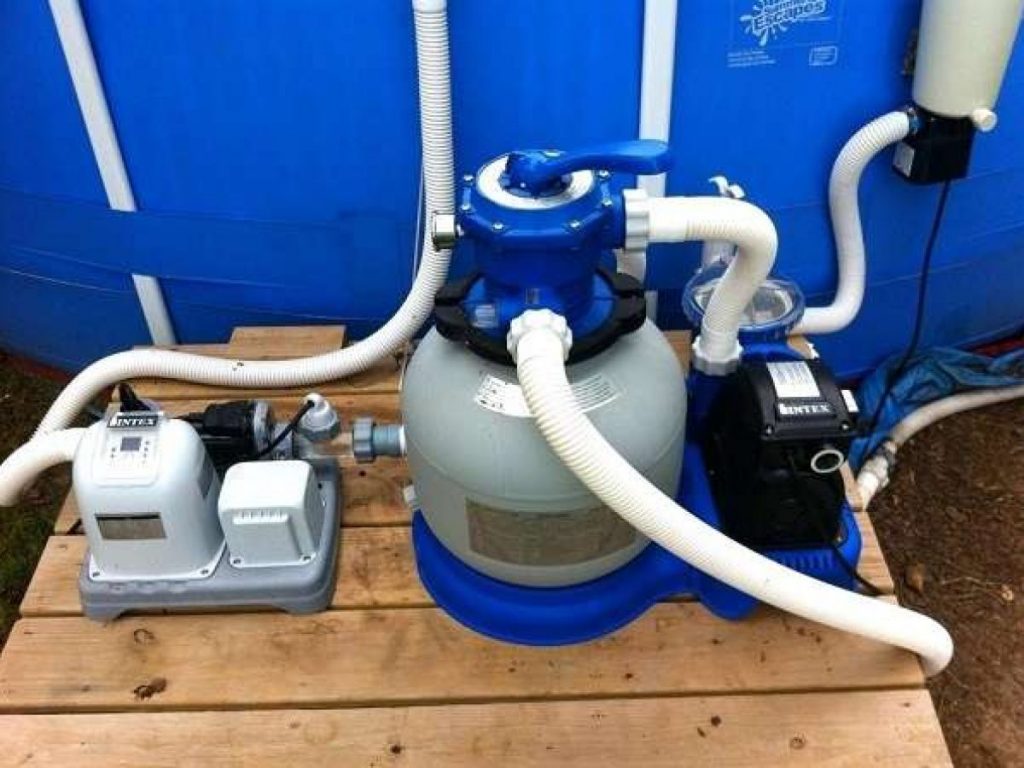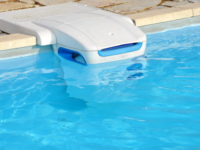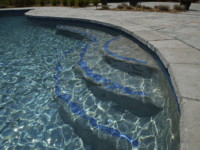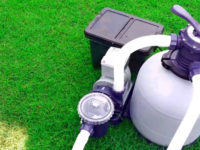A pool is a great addition to any backyard. It can be used for swimming, sunbathing, and as an entertainment space for parties and barbecues. But the most important thing about owning a pool is maintaining it properly so that you can enjoy all of its benefits without having to worry about safety issues or high maintenance costs.
One of the most important parts of pool maintenance is installing a sand filter pump — something we will cover in detail below.
How sand filters work
A sand filter works by trapping particles in the pool water. The pump runs water through the sand, trapping the dirt and debris. The pump then returns clean water to your pool via a filter pipe which connects it directly to the skimmer of an above-ground pool.
An above-ground pool sand filter works in much the same way as its larger in-ground cousins. The primary difference is that the sand filter sits on top of or beside your pool, rather than being built into the earth around it.
Above-ground filters work best when they’re set up to fit against a flat surface like a concrete patio (as opposed to an uneven surface like a hill).

What to consider before installing a sand filter
There are a few things you need to consider before installing a sand filter. These include:
Speed
Single-speed
Single-speed pumps are generally the most economical. They are also easy to install and maintain, which makes them a good choice for less serious pool owners who don’t want too much hassle.
Dual-speed
Dual-speed pumps are the most common type. It has a wider speed range than single-speed ones, and that makes it suitable for almost any above-ground pool size.
Dual-speed pumps come at an average price tag. The advantage of these sand filters is their versatility which saves you hundreds of dollars on installation costs as you don’t have to use more expensive variable-speed pumps.
Variable speed
Variable-speed pumps are more suitable for above-ground pools that have an in-ground pool pump size of 18′ or larger. Variable speed sand filter pumps are quite expensive, but their main advantage is the ability to adjust the flow rate according to your pool needs which saves you money on energy bills in the long run.

Size of your pool
You need to consider your pool size when choosing a sand filter pump. The bigger the diameter is, the more powerful and expensive a sand filter system you’ll need which means that it will also be pricier.
For example: for an 18′ in-ground pool with a sand filter we recommend installing at least 4300 gph rated variable-speed sand filter pump.
Horsepower
The pump horsepower is an important factor that determines the flow rate and how powerful a filter system you’ll need.
For example, an above-ground pool that has a sand filter pump size of 18′ needs at least a 0.75 horsepower (hp) rated single-speed or dual-speed pump to work properly. However, if you have a large in-ground pool with a larger diameter, it is recommended that you install the most powerful variable-speed system.
The size of your above-ground pool determines the horsepower you need to buy for the sand filter pump to work properly.
Noise level
The sand filter noise level is another important factor as it determines how loud the pool pump will be. The general rule of thumb when choosing a sand filter system for your above ground pools is that:
Installation of a sand filter for an above-ground pool

Tips before getting starting
Before getting starting to install a sand filter pump, you should have a few things in place.
- First, having the pump itself will be your main item to purchase.
- Second, have some PVC piping on hand so you can hook up the pool filter system when everything is installed and ready to go.
- Third, if needed have an air compressor or air blower available for the installation.
- Lastly, you’ll want to have a container with an open-top so it can be used for the sand filter media after installing everything is finished.
It may seem daunting to install your pool system but keep in mind that there are no special skills required and anyone should accomplish this task within half a day or less. As long as you have the right tools, which are simple enough to find in most cases, you should be able to get started with no problems.
You may need some assistance from a friend when it comes time for lifting your new pool filter system into place because of its size and weight so having someone there is help if needed.

Step 1: Unpack and сheck the parts
The first step is to unbox everything that comes with the pool filter system so you can have a look at your items before going any further. That will give you an idea of what’s involved in this entire process from start to finish. Once unpacked, take out all of the necessary components and make sure they are in working order. You should be able to see the sand filter, which is a round-shaped device with some different features on top such as gauges and valves.
Step 2: Attach the drain and pre-filter assemblies
Once everything is unpacked and you’ve checked over all of the parts, your next step is to attach the drain assembly as well as the pre-filter. You can do that by sliding on both items because they are made for each other so just fit them together like puzzle pieces making sure it’s secure before moving forward.
Step 3: Secure the system to the base plate
The base plate of this system is going to be a flat piece with the same size and shape as your sand filter. Take it out of its packaging, place it on top of a flat surface if needed for stability purposes, then line up that threaded fitting from the bottom part of the pool filter with an opening in one corner or side section.
Step 4: Set up the pump and control valve
The next step is to hook up the pump and it’s going to be a simple process that only requires you to match part numbers together for each one. After that, attach the control valve so both of them are on at this point but not yet hooked up with any piping in between them. This will allow you room to add some water to the pool and know that everything is working properly.
Step 5: Set up the filter tank
Before you can set up the filter tank, which is a good size to have for this purpose, you’ll need to cut out a small section of PVC piping from one end so it’s open and ready to receive water. It should only require about two inches or so in length because there will be another opening on top where all of the water comes in.
After cutting out this small section, slide the filter tank onto your pool system and get it ready for use by placing the PVC piping into its opening at one end to complete that process. After everything is lined up properly, you can turn on water supply lines so they are running through all of these different components while connecting them. This will make the entire system work like one bigger unit and get rid of any water leaks that you can see or hear if they occur.
Once everything is connected, turn on your pool pump so it begins filtering out all of the dirt particles in the water. At this point, take a look at both sides of your sand filter to make sure the water is moving into it and that there are no leaks or problems like clogging. If you see any dirt particles still floating around, this indicates a problem with your filter system which needs to be addressed by cleaning out the sand first before turning it on again.

Step 6: Add the filter sand and water
Once everything seems to be working properly, you can add some water and filter sand at the same time. You’ll need about 60 pounds of this material in total so make sure it’s available before moving on with your process because adding too much or not enough will cause problems later when trying to create a balance between these two items.
After laying out the filter sand inside of your pool’s filter tank, add in some water and let it settle into place. After the water has drained, you can add more if needed and repeat this process until it’s clean enough to swim in without feeling any dirt or other particles on your skin.
Step 7: Install the filter valve
The next step is to install the filter valve which does require some digging for it to be installed correctly. After removing all of the dirt and debris, you’ll need a leveling shovel or flat part of your garden hose that can act as one so everything lines up right when placing this on top.
Step 8: Install the remaining hoses or pipe
The last part of the process is to install pipes onto both ends for use with your pool system. Once these are in place, you can turn on water supply lines so all components begin working together and getting rid of any dirt particles that will end up clogging them over time if they’re not properly filtered out.
With everything now connected and working together, you can turn on your pool pump and watch the water come through each component for any leaks or problems. If everything seems to be working properly at this point with no changes needed in future process steps, then congratulations are in order because you’ve installed a sand filter onto your above-ground swimming pool.

Pool filter operating tips
- Never backwash the pump when it is running.
This will cause wear and tear on the motor which you are trying to protect by not running it dry.
- Do not let your sand pool get too dirty.
A dirty pool filter will have to work harder, thus increasing the wear and tear on the pump as well as unnecessary water usage from more backwashing being necessary.
- Do not run your sand filter without a prefilter sock installed in it.
This may cause damage to internal parts of the system or an increase in maintenance down the road.
- When you first set up your sand pool filter, or after a few years being stored away for the winter months, always backwash it for at least 30 minutes before turning on the pump again.
This will help remove any particles which could cause wear and tear on internal parts of the system.
Always remember to follow these basic guidelines when using your sand pool filter so that you can see many years of hassle-free service.

Summary
Sand filter pumps are the most commonly used type of pool pump. When combined with a sand filter, they can help to maintain crystal clear water for an aboveground swimming pool by removing bacteria and other particles from it. Sand filters use granular filtering media composed primarily of silica-based minerals such as diatomaceous earth (DE), fossil shell flour, or a mixture of both. The material traps tiny particles, which are then flushed down the drain with normal pool water circulation through the filter.
Sand filters require regular maintenance to ensure they continue to work correctly and efficiently throughout their lifespan. This includes replacing DE every three months as well as backwashing regularly (every few days to weeks, depending on the pump flow rate and pool use).
FAQ:
🧐 How do sand filters work?
Sand filters are one of the most common types used for in-ground swimming pools. They use a bed of sand through which pool water is circulated and filtered to remove debris such as leaves, dirt, and other contaminants.
🔎 What to look for when buying a sand filter pump?
There are several things to consider before buying a new pool pump, such as the size and shape of your swimming pool or spa, how much space you have in which to install it, and what type of motor is most appropriate. Other factors include flow rate, filtration efficiency, energy consumption, and pump warranty.
📝 What is involved in a sand filter installation?
First, you need to decide where the pool equipment will be located. Once this has been decided on it’s time for installing your swimming pool or spa pump. Ensure that there is an adequate power supply available and then install the pipework leading from the pump. This is followed by the filter itself, attaching it to the pipework before filling your pool with water and starting up your new equipment for the first time.
❓ What operating tips should I follow?
Once you have installed a sand filter few things need to be done on an ongoing basis to maintain optimum performance levels. These include: regular backwashing (usually once a week), draining and flushing the filter, voltage checks, and cleaning. The frequency of these tasks will depend on how much you use your pool or spa and what type of contaminants it is exposed to such as leaves, dirt, or hair.




